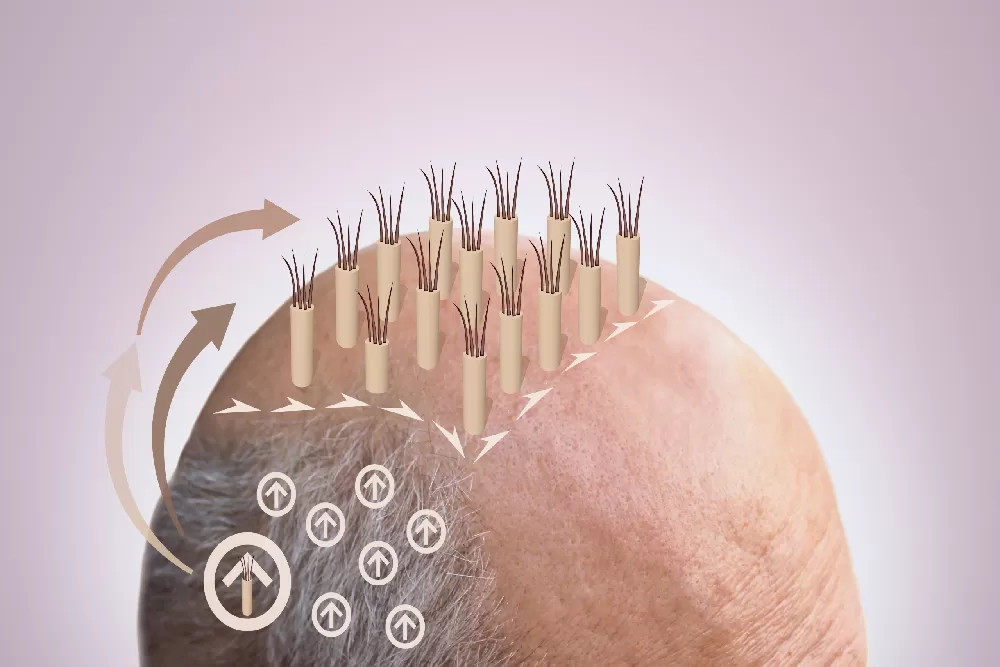In Mexico, five out of ten men between 20 and 30 years of age suffer from alopecia, while three out of ten women suffer from the same condition, better known as baldness. Every day we lose between 100 and 150 hairs, and this is normal as the hair fibers are renewed, but as the forehead line moves further and further away, generating the “receding hairline”, or there are large areas on the head where the lack of hair is perceived, the situation becomes more complex.
Unfortunately, hair loss as a result of androgenic alopecia has no cure, as it is a multifactorial, genetic, chronic and progressive disorder, which can only be delayed, concealed or stopped in some cases. In others, hair loss is due to diseases such as anemia or lupus, and treatments such as chemotherapy to fight cancer.
People affected by alopecia often look for solutions to stop hair loss, recover and strengthen their hair, as it is a situation that can affect their self-esteem. Although there are many home remedies, drugs and cosmetic products that claim to help hair growth, the reality is that the only option to recover lost hair is hair transplantation.
For years, these procedures were expensive, painful and did not offer natural results; however, medical and technological advances have made it possible to design new minimally invasive techniques, with natural results and at affordable prices. These are the FUT, FUE and DHI techniques, and below we will tell you what they consist of and what their differences are so that you can analyze, together with your doctor, which is the best option for you.

Tabla de Contenidos
FUT Technique
Follicular Unit Transplantation, FUT, also known as the older strip technique, in which a suitable piece of tissue is selected from the donor area, which is usually the back of the head, and a strip of scalp up to 20 centimeters long by one centimeter wide is extracted, leaving a hidden scar under the remaining hair.
The amount of hair obtained depends on the hair density of the donor area and the area to be covered; subsequently, this strip is divided into small units to implant the follicles in the recipient area for which small holes are made.
The main advantages of this method are that it is the most economical, allows to obtain the largest number of follicles and treat a large area. However, the disadvantages are the long horizontal scar on the back of the head, the recovery period of 10 to 14 days, and that it can be painful, since the extraction involves cutting skin and blood vessels.
FUE Technique
The Follicular Unit Extraction technique or FUE (Follicular Unit Extraction) emerged in the 2000s to replace the FUT technique. As its name suggests, FUE allows follicular units to be extracted from the donor area to be grafted in the implantation area.
The harvested grafts, which are small pieces of tissue with up to four hair follicles, are prepared with a plasma solution and sorted for implantation, for which incised channels are made in the recipient area to graft them one by one following a natural pattern.
The advantages are the natural results, with very small scars that are not visible, it is a technique suitable for people with short hair, and a recovery period of about a week. However, the disadvantages are that it is a more expensive method than FUT, it takes doctors a long time, and the treatment given to the follicles can decrease their survival rate. In addition, since small holes have to be drilled for implantation, it is painful for the patient.
DHI technique
The Direct Hair Implantation technique, or DHI technique, is the newest technique, in which follicles are manually extracted one by one from the donor area. While this is similar to FUE, in the DHI technique the follicles are implanted directly into the recipient area with an implantation pen, which avoids the need to open channels in the recipient area.
With the DHI technique, the incision and the implantation of the graft are performed simultaneously, resulting in a less invasive technique, practically painless, with natural results and a better design of the hairline.
The advantages of the DHI technique are the natural results, without scars, with minimal discomfort and a recovery period of between four and six days, with the highest survival rate of the follicles (97%) and that allows a greater density of hair than with FUE (45 to 60 grafts per square centimeter with FUE, compared to between 80 and 90 grafts per square centimeter with the DHI technique).
As cons we find that the duration of the procedure is between eight and nine hours, and that the price is higher. However, the results speak for themselves and the investment you make today can be seen in the mirror every day.
In HairFix we are a hair transplantation in Mexico and we have doctors in the DHI technique: the newest in the world and that can only be performed by highly trained doctors.
If you are considering a hair graft to recover your hair lost due to alopecia, now is the time to make your evaluation appointment with the experts at HairFix. Write us through our contact form for more information and to schedule your consultation, we will gladly assist you. Ask us about hair implants for men cost and all the services we have for you.
Additionally, if you’re interested in alternative options, you can explore the benefits of stem cell treatment for hair loss in Mexico. This innovative treatment has been gaining popularity as an effective solution for regrowing hair. For more details, visit our blog where we dive deeper into how stem cell therapy can help with hair restoration.





